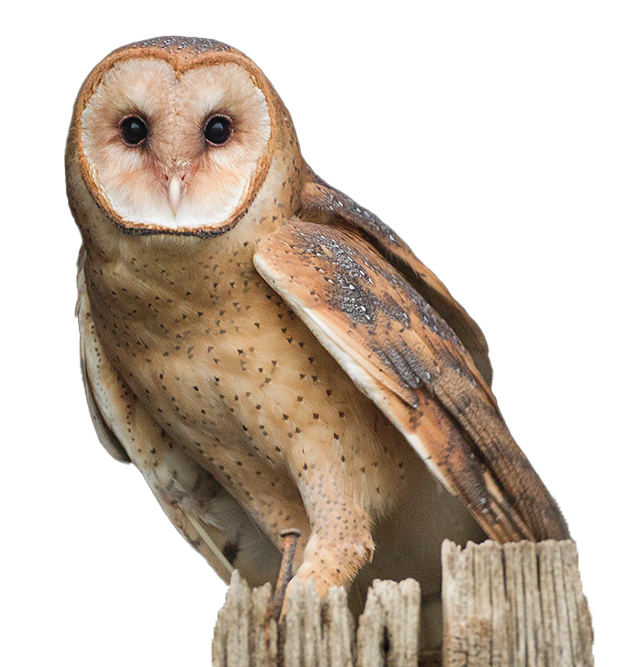
By Richard G. Biever
On the drizzly windy Sunday afternoon before Thanksgiving, two wildlife biologists with the Indiana Department of Natural Resources stood in mud and manure beside a cattle barn. They stared up at a silo and scratched their heads. Deep inside the 22-foot-tall cylinder were five Indiana-endangered barn owl chicks.
The empty unused silo had served as the perfect nest for a pair of barn owls for years. But now, Gibson County cattle farmers Darrel and Cheryl Siekman were needing it to store feed for their animals. So began a rescue mission the two biologists, Amy Kearns and Jason Mirtl, described numerous times as “sketchy.”
The silo tapered into a funnel with openings at the bottom. Though the birds nested on remnants of feed maybe just three feet above those openings, the silo hadn’t been used for seven years. The grain had turned as hard as rock. The only way to get the birds out was through the opening at the top.
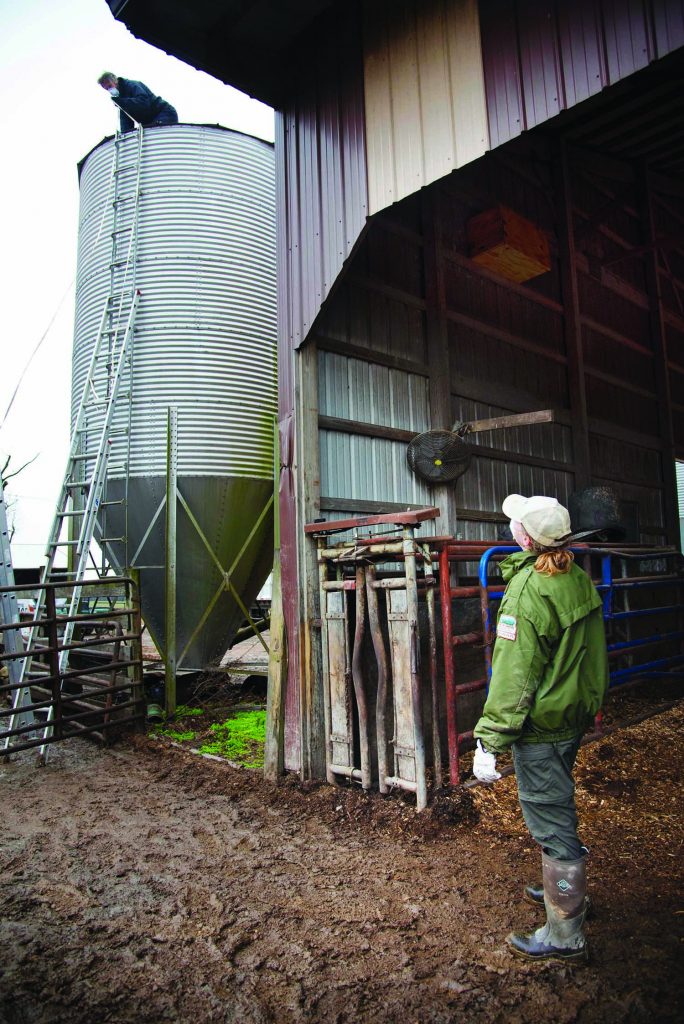
Kearns, assistant ornithologist with the Division of Fish & Wildlife, and Mirtl, who normally works with reptiles and amphibians but volunteered to help Kearns this day, hadn’t come prepared for such an involved operation. But rather than wait and hold up the Siekmans’ farm operation, they worked with the family to gather rope and a deer-stand safety harness.
Secured safely by a rope wrapped around the tubular bumper of the Siekmans’ utility vehicle, Mirtl, a rock-climbing enthusiast, descended into the silo. He called out instructions to Cheryl Siekman — when to give slack and when to tighten — until he reached a teetering 16-foot extension ladder he had earlier lowered in. He then stepped down to the birds.
Stepping up
This was not a text-book rescue, but few are. Improvisation and determination most often win the day when working with wildlife in unforeseen circumstances. Kearns and Mirtl knew failure would not be an option for these rare birds.
Once common, barn owls have virtually vanished from the state. Fewer than 20 barn owl nests were known to exist in Indiana a decade ago. In the latest survey in 2017, that number was up to only 43.
The survival of the barn owl depends on the success of continuing DNR programs and efforts to protect them. Having the support of landowners, like the Siekmans, is imperative.
“Leaving them be would have been the best strategy for that particular brood of owlets, but it wasn’t a good option for the farmer,” Kearns noted. “So, we put our heads together and came up with a plan that would benefit the owls and the farmer. It’s a good example how private landowners and the DNR can work together to save endangered wildlife.”
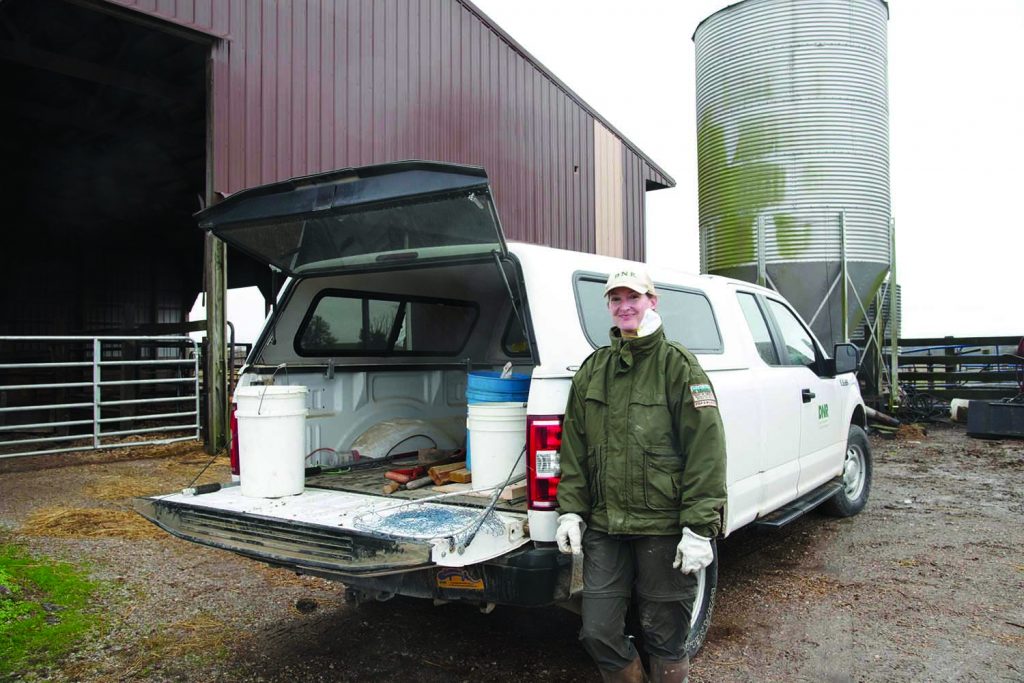
Raised in a barn
The barn owl, named for its preference for nesting in barns, became endangered in Indiana with the loss of grassland habitat and secure nesting sites. The small distinctive owls have a heart-shaped face with dark eyes.
It is one of more than 750 animal species supported by the DNR’s Nongame and Endangered Wildlife Program. The program, funded through donations to the DNR Nongame Wildlife Fund, has placed more than 400 nest boxes for barn owls since 1984.
“Boxes are really helpful for the species because it is vulnerable to predation,” Kearns explained. “If the owls are just nesting on some old hay in the loft of the barn, a lot of times they’ll be eaten by raccoons.”
Nest boxes, she said, get the chicks up off the ground and into a secure surrounding. The entrance hole cut for the owls is small, so bigger predatory birds, like great horned owls, can’t get in. “If they have great habitat and lots of food,” Kearns added, “they can have two broods each year.”
That’s what the pair in the Siekmans’ empty silo had done. That’s why a clutch was there so late in the year.
Seven years ago, the owls took advantage of a ding in the top hatch of the silo. A small opening and the silo’s tall steel sides made it an impenetrable tower to any predators. The Siekmans let the birds use it as an ongoing incubator and aviary.
In the fall, though, they let the DNR know they needed to reclaim the gravity-fed silo. Darrel Siekman, who turns 69 this month, implied he’s no spring chick himself anymore. The daily grind of shoveling cattle feed out the side hatch of a grain bin they had been using was becoming too much.
Cheryl said a lot of farmers may not want to be bothered with an endangered bird on their land, let alone make concessions. But she said she considers themselves part of a team with the DNR. “Everything we have God has given us, and we need to respect His creation, as well. We’re trying to coexist rather than just say, ‘This is ours, and we are going to take it,’” she said. “So, we’re doing our best to preserve nature and still run a productive farm.”
Besides, she said she appreciates what the barn owls do as top-flight mousers. “Anytime you have cattle, they drop feed and that brings mice. Barn owls are great predators for those mice, and that makes me happy that they’re here.”
A bird sanctuary
Back at the rescue, when Mirtl reached the brood at the bottom of the silo, he bagged each bird, one-at-a-time. He tied the bag to a rope, and Kearns, stationed atop the silo, pulled each up. She then lowered each bag with the same rope to Cheryl Siekman on the ground.
After all five chicks and Mirtl were safely out of the silo, Mirtl and Cheryl helped Kearns band each bird with a small ID bracelet the bird will wear the rest of its life so its movements and mortality can be tracked.
Before beginning the rescue from the silo, Kearns and Mirtl installed a nesting box in the gable of the adjacent barn that would become the new home for the family of owls. As close to the top entrance of the silo as possible, Kearns cut an “X” in the barn’s metal siding and carefully folded back and crimped the edges to create a safe 5-inch square opening to the outside. They then mounted the 16-inch x 32-inch x 16-inch box over the opening.
Later, after each banding, Kearns carried each bird up an extension ladder and placed it in the nesting box. To prevent the adult owls from returning to the silo, Darrel repaired the opening in the hatch.
A couple of days later, Cheryl reported seeing the adults flying at night, as well as smudges around the entrance of the new nest box. “The smudges are a good way to tell that the adult owls have been in and out dropping off food for the nestlings,” Kearns said. “So, it appears that the re-nesting was a success. Those big chicks are the perfect age for re-nesting since they are big enough and loud when begging for food to make it easy for their parents to find them.”
No one seemed happier about the success than Cheryl. Like a proud godmother holding the baby at baptism, she gushed with joy cradling the chicks during the banding. Her smile was hidden behind the face mask she wore when working beside the duo from the DNR, but the twinkle of her eyes couldn’t be missed.
“Farmers often don’t get to see the fruits of their labor,” she said. “We sell to the stockyard. We don’t get to see it go to the table. But we get to see this from the start to finish, and we have years and years and years where now these boxes will be productive, and we can still stay productive raising beef.
“This is a sanctuary,” Cheryl continued. “It’s a very special place we have here. We feel that we live in heaven …,” and, as if on cue, a cow bellowed loudly in agreement from behind her, “… and the cows like it,” she laughed.
“Now, that we need our grain bin back,” she said, “we’re going to extra lengths to preserve the owls and their habitat.”
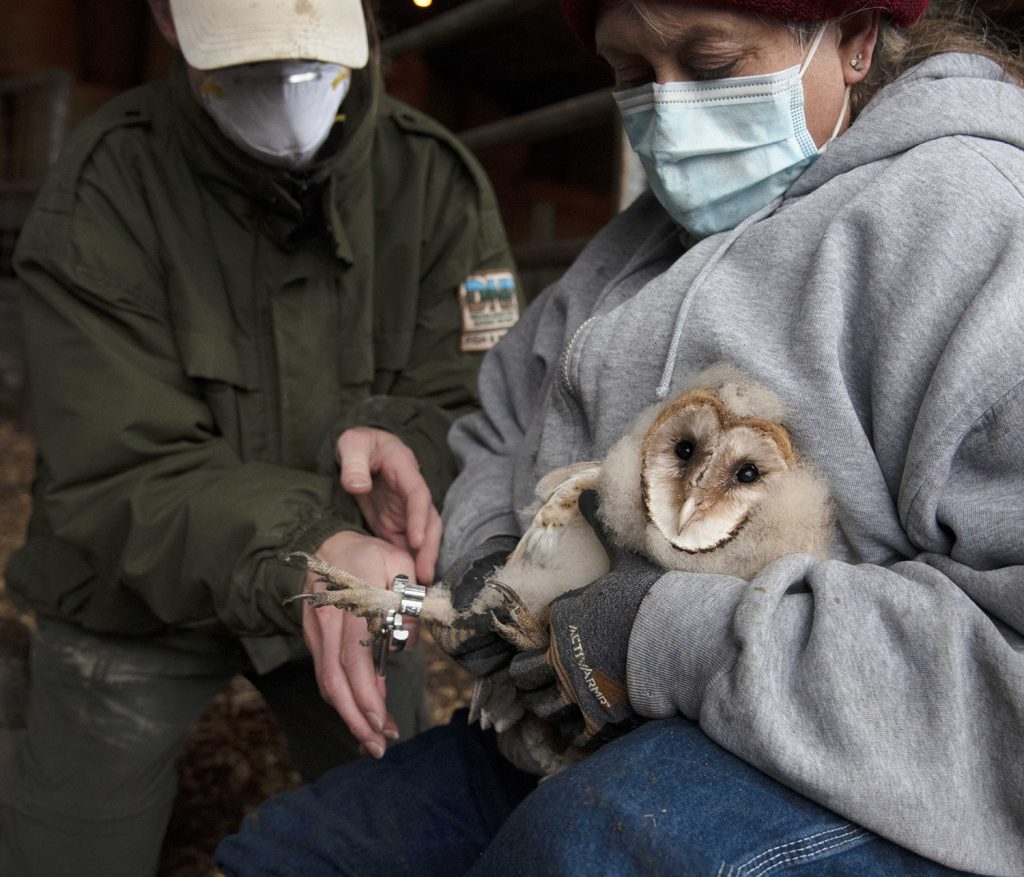
For more information about barn owls, including a step-by-step guide on how to build your own nest box, please visit: https://www.in.gov/dnr/fishwild/3382.htm.
To check out the DNR live streaming barn owl nest cam, go to: https://www.in.gov/dnr/fishwild/8183.htm.
RICHARD G. BIEVER is senior editor of Indiana Connection
Shrubs for Shrikes
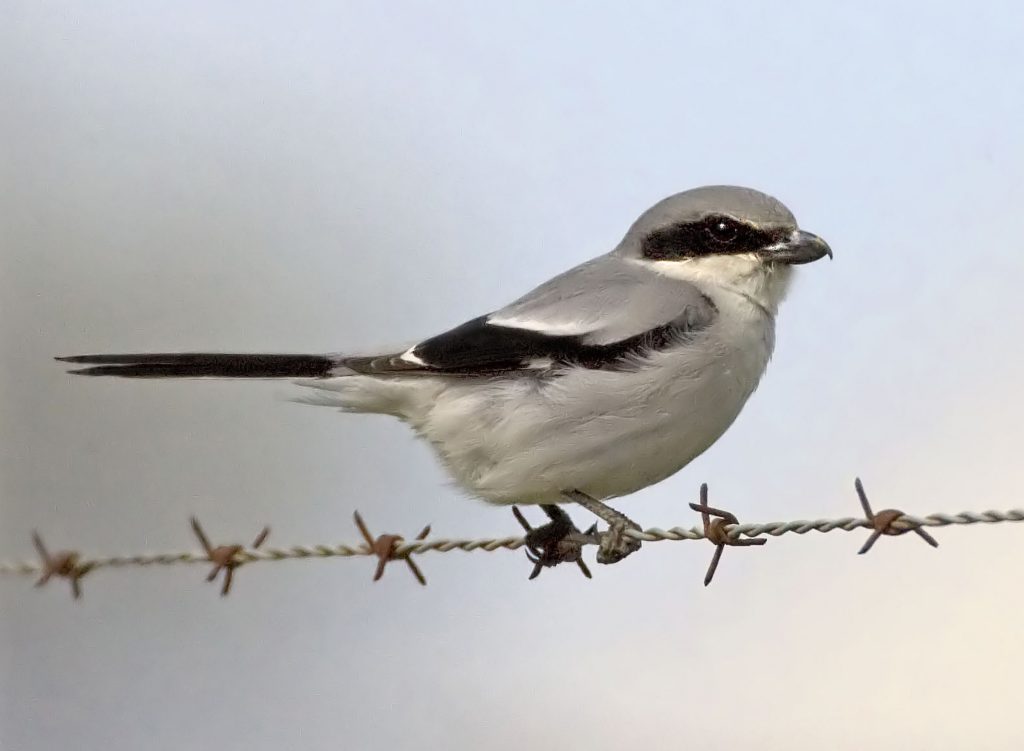
A smaller bird that shares much of the same grassland habitat with the barn owl and is even more endangered in Indiana is the loggerhead shrike. Only seven nesting pairs were found in the entire state during the most recent count. The seven were concentrated in the southern counties of Daviess, Lawrence, Orange and Spencer.
The loggerhead shrike is a songbird slightly smaller than a robin. Its striking appearance includes a broad black mask through the eyes. Despite its small stature, its habits reflect those of a raptor. Its strong, hooked bill allows it to take diverse prey that include mice, voles, house sparrows, snakes and frogs. Loggerhead shrikes hang their prey from thorns or barbed wire to provide an anchor while they tear their prey into bite-sized pieces.
Prey hung in this way can also be conveniently stored for later, like the bird’s personal meat locker. This behavior has earned it the nickname of “butcher bird.”
“There’s only one bird that is going to impale a snake on barbed wire, and that’s a shrike,” said Amy Kearns, assistant ornithologist with the Indiana DNR. That’s one way to know if you have shrikes on your land.
Shrikes most frequently nest on traditional farms with livestock pasture and smaller fields bordered by shrubby hedgerows and fence lines. Nests are usually in a shrub or small tree. Eastern red cedars and rose bushes are favorite nesting sites along the fencerows.
Through a new partnership among the DNR, the U.S. Fish and Wildlife Service, private landowners and the Indiana Audubon Society, Hoosiers can now “adopt a shrike.” Half the proceeds from these adoptions help fund the planting of eastern red cedars for nesting shrikes. Donors will receive an adoption certificate, an annual report on shrike banding efforts, and a “Never met a shrike I didn’t like” T-shirt. Each adoption is $50 and can be purchased at IndianaAudubon.org/adopt-a-shrike/.
For information about shrikes, please visit: www.in.gov/dnrfishwild/3370.htm.
To contact the DNR about either barn owls or shrikes on your property, please contact Amy Kearns at: 812-849-4586, ext. 223, or email: akearns@dnr.IN.gov.
To donate to the Indiana Nongame Wildlife Fund that supports conservation programs like these and others, go to: www.in.gov/dnr/fishwild/3316.htm.



